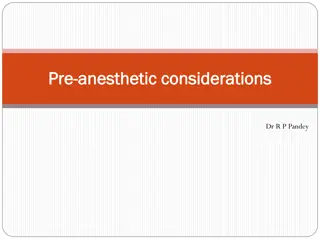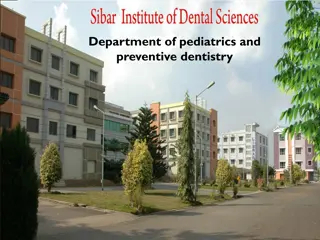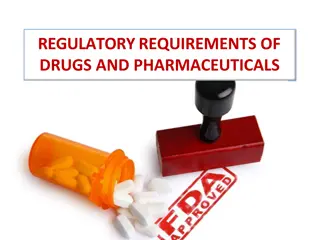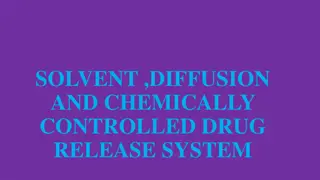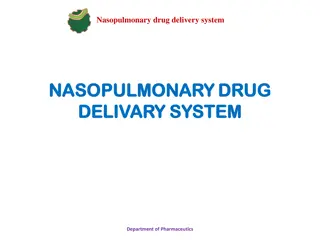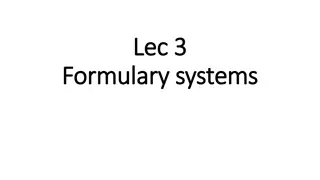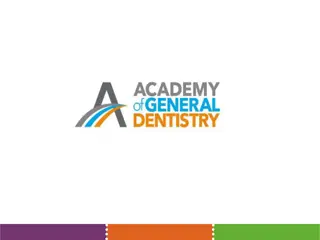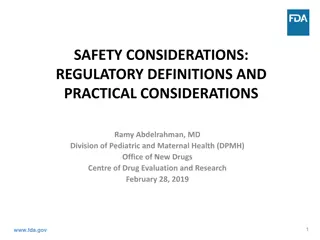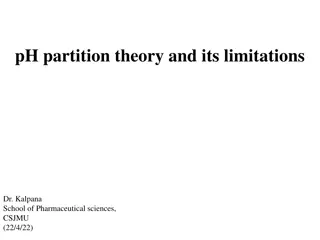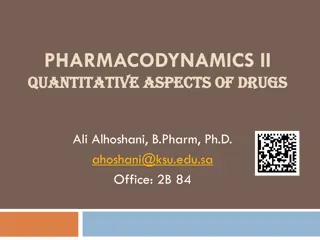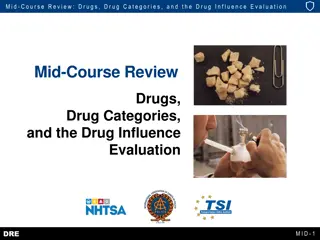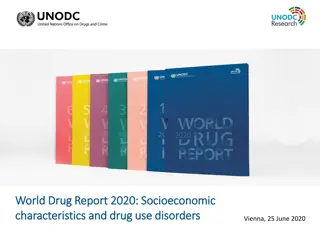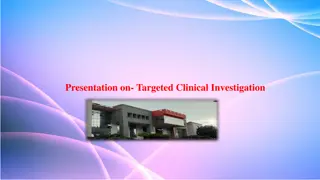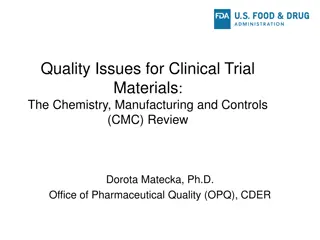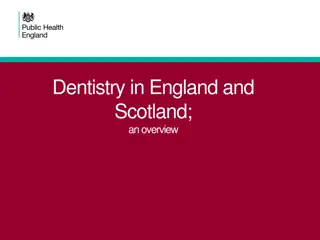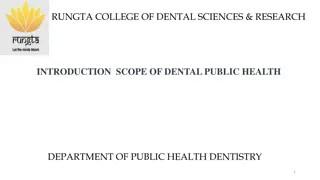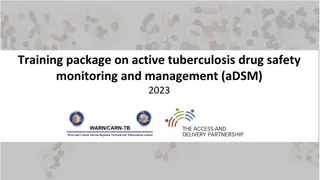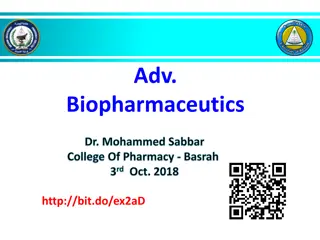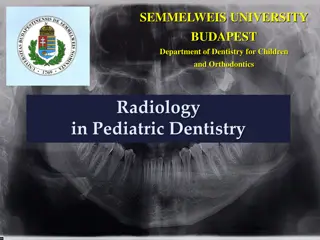Understanding Drug Administration in Dentistry: Safety and Considerations
Drug administration is common in dental practice, with categories including local anesthetics, analgesics, antibiotics, and CNS depressants. Safety, rational use, and principles of toxicology play vital roles in preventing adverse reactions and emergencies. Proper administration is crucial for effective treatment and patient well-being.
Download Presentation

Please find below an Image/Link to download the presentation.
The content on the website is provided AS IS for your information and personal use only. It may not be sold, licensed, or shared on other websites without obtaining consent from the author. Download presentation by click this link. If you encounter any issues during the download, it is possible that the publisher has removed the file from their server.
E N D
Presentation Transcript
R. John Brewer NREMT-P Dental Education Inc.
The administration of drugs is common in the practice of dentistry and oral surgery. The majority of the drugs used in dentistry can be divided into four categories. 1. Local anesthetics 2. Analgesics 3. Antibiotics 4. CNS Depressants
Important part of the dental treatment plan when potentially painful procedures are considered.
Prescribed for relief of preexisting pain or alleviation of potential post-operative pain.
Prescribed for all phases of the dental treatment for the prevention and management of dentistry related fears.
Whenever a drug is administered, a rational purpose should exist for its use. Indiscriminate administration of drugs is one of the major reasons the number of incidents of serious or life threatening emergencies in the medical and dental office have increased.
It is estimated well over 100,000 patients have died in hospitals due to adverse drug reactions. It is estimated that over 2 million patients have suffered serious but non fatal adverse drug reactions.
Toxicology is the study of the harmful effects of chemicals on biological systems. These effects range from minor to serious, or even cause death. Whenever a drug is administered, two types of reactions may be noted. - Desirable drug reaction - undesirable drug reaction
General principles of toxicology - No drug ever exerts a single action. - No useful drug is entirely devoid of toxicity. - The potential toxicity of the drug rests in the hand of the user.
Our goal is to give the correct drug in the correct dose, via the correct route to the correct patient at the correct time for the correct reason. It is very important you know about the drugs that you have in the office or prescribe to the patient.
Most Adverse drug reactions do not pose a threat to the patients life. There are three responses to drugs that are life threatening: - Overdose reaction - Allergic reaction - Idiosyncrasy reaction
A condition that results from exposure to toxic amounts of a substance that does not cause adverse effects when given in smaller amounts .
Defined as a hypersensitive response to an allergen to which the individual has been previously exposed, and now has developed antibodies. Allergic reaction is possible with any drug or substance.
The drugs and substances most likely to cause allergic reactions. - Aspirin - Penicillin - Bisulfites - Latex
An individuals unique hypersensitivity to a particular drug, food, or other substance. Management is to position the patient, ABC S are vital.
The major cause of drug related emergency situations in the dental office is the administration of local anesthetics. Although true Adverse reactions occur ,most reactions are related to the injection(seeing the needle)
Syncope and hyperventilation are the most common drug related emergencies. These episodes usually result from emotional stress receiving the local, not from the drug itself.
Locals is the most widely used drugs , are the safest, and most effective drugs for the prevention, and management of pain. It is important to stress again that most adverse drug reactions to locals are a result of the administration, not the drug.
The next most common adverse drug reaction is the toxic reaction. This is produced by a relative overdose secondary to accidental intravascular injection. True documented allergic reactions to locals is extremely rare.
Prescribed to treat established active infections Should only be used when indicated due to resistant bacteria strains and allergies.
Pain relieving drugs make up a significant portion of scripts written by dentists.
Two categories of analgesics mild-non opioid strong opioid
Mild-asa, ibuprofen, Tylenol Strong-Opioid-codeine, demerol, diludid, vicodin oxycontin
Adverse drug reactions to the mild analgesics are GI upset, nausea, constipation, itching Adverse drug reactions to the opioids are nausea, vomiting, and orthostatic hypotension, respiratory depression, respiratory arrest.
Aspirin, Tylenol and Codeine remain the most commonly prescribed drugs.
The use of these drugs for all phases of dental care has increased significantly over the years. The most common drugs prescribed is the benzodiazepines.
An overdose of a local is related to the blood level of the local in the myocardium and Central nervous system. There are several factors which influence the rate at which blood levels increase or for which blood levels remain elevated. These factors could be drug or patient related.
Normal distribution curve. This is where the majority of patients responds appropriate with normal dose , However some are less responsive, and some become more responsive to the local.
Age Due to absorption, metabolism, and excretion drug doses should be decreased for patients under 6 years and over 65 years. -Weight > Lean body weight more of the drug the patient can tolerate. ***A lack of consideration of body weight is one of the major causes of overdose reactions.
Pathological process Presence of Pre-existing disease may alter bodies ability to transform a drug into a biologically inactive substance. Patients with CHF demonstrate blood levels of locals 2x those found in healthy patients receiving the same dose.
Patients with chronic lung disease are at increased risk for local overdose. CO2 retention results in the decrease of the seizure threshold for local anesthesia. If a patient has a PCO2 of 65-81 their seizure threshold is lowered by approx 53%.
Genetics It is been reported that there are certain individuals that possess genetic deficiencies that alter their response to certain drugs.
Attitude It has been shown that the seizure threshold for locals is lowered in patients who are overly stressed.
Vasoactivity Locals that are more lipid soluble and more highly protein bound are retained longer, therefore having a slower absorption rate. This increases the margin of safety. The greater the degree of vasodilatation, the more rapid the local is absorbed.
Dosage : The larger the dose the higher the peak blood level.
Route of Administration: Inadvertent intravascular is the factor that causes most overdoses.
Rate of Injection The rate of injection is vital in the cause or prevention, of overdose reactions to all drugs.
Local Anesthetic overdose reactions can result from the combination of inadvertent intravascular injection, combined with too rapid a rate of ingestion. Both 100% preventable
The more vascular the area, the faster the absorption rate will be.
The addition of a vasoconstrictor to a local results in a decrease rate of systemic absorption of the drug.
Low to moderate overdose - Confusion - Talkativeness - Apprehension - Excitedness - Slurred speech - Generalized stutter - Muscular twitching, tremor to face,and extremities
Nystagmus Elevated blood pressure Elevated heart rate Elevated respiratory rate
headache Feeling lightheaded dizziness Blurred vision Ringing in ears Numbness of tongue Flushed or chilled feeling Drowsiness Disorientation and loss of consciousness
Management is based on its severity. -again most cases are mild in nature requiring little or no treatment. Most local overdoses again are self limiting. Rarely should you go beyond just administering a little 02. Over treatment has the potential to become a problem.
It is imperative when administering a local, that the patient remain under continual observation, during and after administration of the local. Again mild local reactions, will begin in 5-10 minutes following injection.
Terminate procedure Position of comfort ABC s 02 administration Vital signs Iv access Administration of anti-convulsant. EMS
If signs symptoms appear immediately (seconds to 1 minute)intravascular injection is the most likely cause. Clinical findings are going to be much more severe and rapid. Patient may immediately become unconscious, and have seizures.
Position patient supine -remove syringe 911 ABC s 02 administration Protect patient Vital signs IV therapy/ anticonvulsant Manage the postictal patient
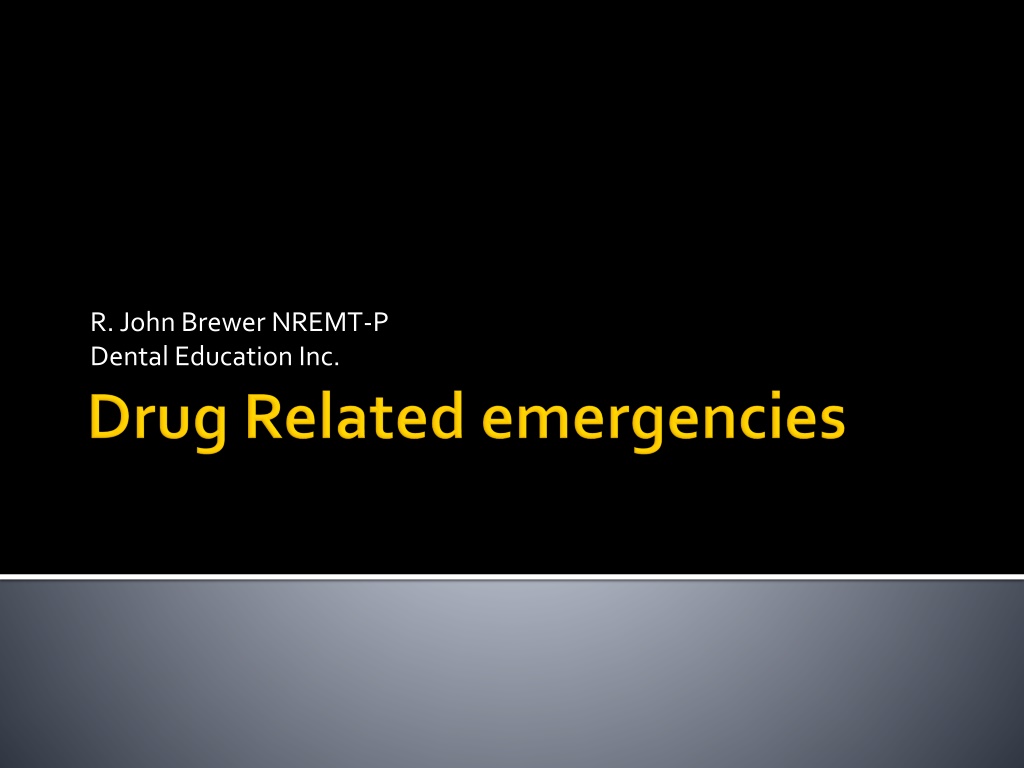
 undefined
undefined









